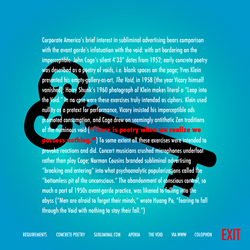Far from plunging us into darkness, Reading Project: A Collaborative Analysis of William Poundstone’s Project for Tachistoscope {Bottomless Pit} provides brilliant and multifaceted reflections on a rapid, serial electronic literature work. (You can read Bottomless Pit for free online, by the way, in ELCv1 and on Poundstone’s site.)
The party that sets out on the adventure of this reading is Paladin Jessica Pressman, who seeks truly through media archeology and quests into thorny literary theories; Thief Mark C. Marino, who slyly reverse-engineers the program and acquires the source code, stealing sequences of words and images along with how they are produced; and Illusionist Jeremy Douglass, who summons visualizations of the piece that dazzle but also unfold new understandings. They ascend from the endless passage of Project, and from the dungeon of collaboration, with numerous new insights, showing how different reading strategies – ranging from rather conventional to quite novel – can inform one another. There’s so much background offered (etymological, historical, bibliographical) that one imagines it being drawn out of a bag of holding. The view of the project that emerges seems beyond what a Beholder would be able to comprehend.
These three cover the fundamental workings of Project well, showing the role of randomness (a saving throw of sequential words does not abolish chance) and how individual pixels shine during a loop of the main story text. What this text means and alludes to, and the presence of a second sequence of less coherent words, is also discussed, and connections are made between such meanings and references and the piece’s material and technical aspects. From the media technology of various historical tachistoscopes to the nature of the pit in Freudian psychoanalysis, there is a great deal about Project that is – let’s not say excavated, but illuminated – in this book.
In its engagement with computation, the relationship of recent computational work to historical and literary concepts, and in the way it helps to develop productive collaborative approaches in the humanities, this is a landmark investigation – almost surely deeper than you imagine. It’s essential reading for those interested in digital literature, but also also for anyone (concerned with e-lit or not) who wonders how humanistic thinking can continue to develop and how thinkers can work together in new ways.


